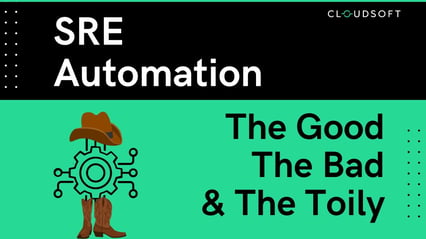What's the difference between DevOps and Site Reliability Engineering?
/carly%20bell.jpeg?width=200&name=carly%20bell.jpeg)
Are DevOps & SRE just two slices of the same technology pie?
Site Reliability Engineering (SRE) is rooted in the principles of DevOps, but SRE is a distinct practice that requires a different approach.
Whilst both SRE and DevOps share similar tools and techniques, such as automation and monitoring, they are applied differently.
DevOps automates agility whereas SRE automates reliability.
So, let’s explore some of the ways SRE and DevOps differ, and how understanding them in this way can enable the development of dependable software at a rapid pace.
What is DevOps?
DevOps is a cultural shift and philosophy that promotes results by combining teams and encouraging collaboration.
DevOps seeks to remove the silos that Developers and Operations teams historically operated within, utilising automation to speed up the process of software development and delivery.
The goal of DevOps is to create an environment that utilises continuous integration, continuous delivery and automation tools to speed up the production and delivery of software and applications.
The benefits of applying DevOps philosophies and practices are:
- Increased speed of delivery for customers
- Rapid delivery to respond to customer needs
- Ensuring continuous delivery and integration
- Increased automation managing and operating systems at scale.
- Automated compliance processes for security assurances
Currently, DevOps is more like a philosophical movement, not yet a precise collection of practices, descriptive or prescriptive.
- Gene Kim Co-Founder of Tripwire Inc
What is Site Reliability Engineering (SRE)?
SRE is a specific role and practice that is responsible for maintaining and improving the reliability and accessibility of software and applications. SRE measures success by MTTR (mean time to recover) from incidents, the availability of the system and the reliability of core software.
High reliability and availability are achieved through automation and monitoring, ensuring that applications and systems meet requirements 24/7. SRE utilises practices such as continuous integration and delivery, but in a way that is focused on delivering a reliable experience.
The adoption of SRE behaviours is going to increase as organisational downtime continues to lead to lost customer trust, which is increasingly difficult to obtain but very easy to lose. SRE is one way to ensure your services are always available and to retain that all-important customer trust, whilst reducing operational toil wasted in fixing and patching up old buggy code that causes downtime as it arises.
Anticipated benefits of SRE include:
- Increased levels of reliability and resilience
- Increased efficiency through automation
- Improved customer retention and satisfaction
- Driving forward a culture of continuous improvement.
SRE is what happens when you ask a software engineer to design an operations team
- Benjamin Traynor Sloss, VP of Engineering at Google
You can have both!
At a time where downtime and inaccessibility are increasingly being viewed as unacceptable and the speed of technological advances seems to not be letting up, the demand for SRE and DevOps outcomes will continue to increase.
By employing both attributes of the DevOps philosophy along with SRE practices, organisations can utilise IAC (infrastructure as code), and automation for monitoring and resolution to increase efficiency and quality.
Fully understanding both SRE and DevOps enables organisations to experience the benefits of both practices, allowing for high-quality, reliable software and applications to be produced at an incredible speed and efficiency that centres the users' needs and requirements.
Read more about good SRE automation in our blog: SRE Automation: The Good, The Bad and the Toily.
